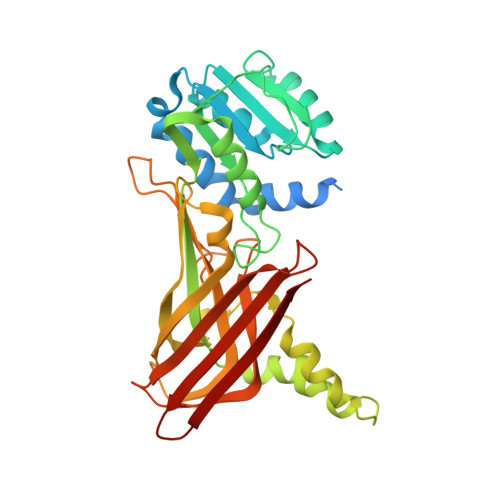Investigation of the molecular origins of protein-arginine methyltransferase I (PRMT1) product specificity reveals a role for two conserved methionine residues.
Gui, S., Wooderchak, W.L., Daly, M.P., Porter, P.J., Johnson, S.J., Hevel, J.M.(2011) J Biological Chem 286: 29118-29126
- PubMed: 21697082
- DOI: https://doi.org/10.1074/jbc.M111.224097
- Primary Citation of Related Structures:
3Q7E - PubMed Abstract:
Protein-arginine methyltransferases aid in the regulation of many biological processes by methylating specific arginyl groups within targeted proteins. The varied nature of the response to methylation is due in part to the diverse product specificity displayed by the protein-arginine methyltransferases. In addition to site location within a protein, biological response is also determined by the degree (mono-/dimethylation) and type of arginine dimethylation (asymmetric/symmetric). Here, we have identified two strictly conserved methionine residues in the PRMT1 active site that are not only important for activity but also control substrate specificity. Mutation of Met-155 or Met-48 results in a loss in activity and a change in distribution of mono- and dimethylated products. The altered substrate specificity of M155A and M48L mutants is also evidenced by automethylation. Investigation into the mechanistic basis of altered substrate recognition led us to consider each methyl transfer step separately. Single turnover experiments reveal that the rate of transfer of the second methyl group is much slower than transfer of the first methyl group in M48L, especially for arginine residues located in the center of the peptide substrate where turnover of the monomethylated species is negligible. Thus, altered product specificity in M48L originates from the differential effect of the mutation on the two rates. Characterization of the two active-site methionines provides the first insight into how the PRMT1 active site is engineered to control product specificity.
- Chemistry and Biochemistry Department, Utah State University, Logan, Utah 84322 and.
Organizational Affiliation:


















